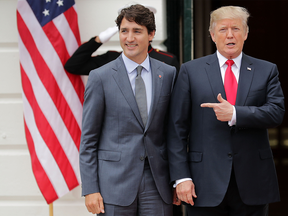Article content
At Friday’s evening’s Mar-a-Lago dinner, when he wasn’t joshing about Canada becoming the 51st state, Donald Trump was nagging Justin Trudeau over Canada’s trade surplus with the United States. For Trump the overall U.S. trade deficit has been a concern since at least the 1980s.
Article content
Trouble is, much of Trump’s economic policy is more or less guaranteed to produce a trade deficit. He obviously wants a strong economy, all presidents do. (Joe Biden thought he had one but nobody believed him.) Trump also likely regards a strong dollar as confirmation of America’s economic greatness, even if it hurts U.S. exporters, and his aggressive tariffs will juice the dollar whether he likes it or not. Finally, he favours strongly pro-investment taxes and regulation. He doesn’t necessarily favour foreign investment into the U.S., but if he makes the U.S. a highly hospitable place for investment, where will the world want to put its extra cash?
Article content
That set of policy goals is not consistent with running trade surpluses. If you’ve got a strong economy, it will be sucking in imports. If it’s growing faster than your trading partners’ economies, they won’t be sucking in your exports nearly as quickly. That pushes you toward deficit.
Same thing if you’ve got a strong currency. It’s tough on exporters and strengthens your consumers’ purchasing-power over foreign goods. (Remember how nice it was to shop or travel in the U.S. the last time the loonie was at par — back at the start of the 2010s?) Result? Deficit.
Same effect from foreign investment. The president may not care whether companies making investments in the U.S. are foreign — so long as they’re not Chinese, Russian, Iranian or North Korean — but 50 governors work hard every day to attract whomever they can to their states and tens of millions of American workers are more than happy to have the jobs that come with foreign investment. What’s the effect of increased foreign investment? A stronger economy, a stronger dollar and therefore more sucking-in of imports and headwinds for exporters.
Article content
Trump got his B.Sc. in economics from the Wharton School way back in 1968. (His B.S. seems to come naturally.) So perhaps he’s simply forgotten his international macroeconomics.
The first thing they teach you in such a course is that the balance of payments always balances. It’s accounting. Inflows balance outflows. If you’re buying more goods from the rest of the world than it’s buying from you, that money gets recycled somehow. If it leaves on the “current account” (via trade and income flows), it comes back on the “capital account” (via investment flows). And vice versa. Thus the U.S. Bureau of Economic Analysis (BEA) noted in its summary of last year’s numbers that foreign direct investment was up and that “the increase mainly reflected a US$96-billion increase in the position from Canada.”
The second thing they teach you in a balance of payments course is that which parts of your payments are positive and which are negative isn’t especially important. The parts do sum to zero but only by complete fluke will every one of them be exactly zero, i.e., exactly balance. An economy that shut itself off from the world — which sometimes does seem to be Trump’s goal for America — could have outflows of zero, inflows of zero and therefore also a balance of zero. But on this planet perfect isolation hasn’t been an option for several centuries now. You’re going to have some surpluses and some deficits.
Article content
The third thing they teach you about the balance of payments is that bilateral balances of the sort Trump is fixating on are meaningless. If the U.S. completely cuts off imports from China, they’ll come instead through Mexico or Vietnam. Or, because China starts dumping manufactured goods in the developing world, prices everywhere are forced down, which stokes competition.
Even if you accept Trump’s mercantilist view of the world, it’s not at all clear why we’re one of his top three targets (along with Mexico and China). BEA data show a U.S. deficit in goods trade for 2023 of US$1.063 trillion. Of 23 major U.S. trading partners the BEA tracks in its summary tables, we had only the fifth largest trade surplus vis-a-vis the U.S. China, Mexico, Vietnam and Germany all had bigger. And ours accounted for only seven per cent of the overall U.S. deficit, to which no fewer than 16 other countries contributed.
And goods are only part of trade. There’s also services. The U.S. runs a sizeable surplus in its services trade with us — US$31.7 billion compared to our goods surplus with them of US$72.3 billion. Maybe we should slap tariffs on U.S. services until the U.S. whittles down that surplus to levels that don’t threaten our domestic services sector, the way the U.S. wants us to stop threatening its goods producers — which we do simply by competing with them.
Put goods and services together, as you should, and we do still run a surplus with the U.S. But now we’re only 10th on the list and account for only 5.2 per cent of the U.S. deficit.
The U.S. needs to face accounting realities: if Trump 2.0 makes America economically great again, America is almost certain to still have a trade deficit. And Canada won’t be the cause of it.
Share this article in your social network


